The Public Life of Sherlock Holmes: The Stuff That Dreams are Made of
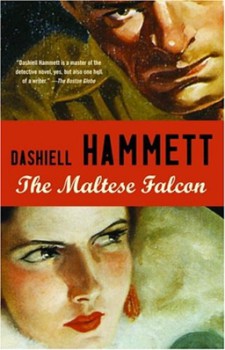 Last week marked the 86th anniversary of Dashiell Hammett’s The Maltese Falcon in book form. It had been serialized the year before in the pages of Black Mask Magazine. Hammett gets my vote for best writer of the hard-boiled genre. And I am quite the fan of Red Harvest (the uncredited source for Bruce Willis’ under-appreciated gangster film, Last Man Standing) and of the Continental Op stories (well worth reading). But I happen to think that The Maltese Falcon is the best private eye novel yet to be written. Period.
Last week marked the 86th anniversary of Dashiell Hammett’s The Maltese Falcon in book form. It had been serialized the year before in the pages of Black Mask Magazine. Hammett gets my vote for best writer of the hard-boiled genre. And I am quite the fan of Red Harvest (the uncredited source for Bruce Willis’ under-appreciated gangster film, Last Man Standing) and of the Continental Op stories (well worth reading). But I happen to think that The Maltese Falcon is the best private eye novel yet to be written. Period.
Sam Spade (who looked like a blonde Satan) also appeared in three short stories, which I wrote about in a prior post here at Black Gate. Sadly, they aren’t particularly memorable and definitely aren’t in the upper half of Hammett’s works. In 2009, Joe Gores wrote Spade and Archer, an authorized prequel. I love Gores’ Daniel Kearney Associates series of books, but I’m still saving this Sam Spade gem for a future read.
A great deal has been written about Hammett’s novel and about Spade himself, including William Maynard’s post here. It’s certainly worthy of a post all by itself. But I’m going to focus on the media Falcon: specifically the third of three filmed versions. It’s far and away the best known and I’m guessing that many people who haven’t actually read the book have seen the movie.
The First Falcon
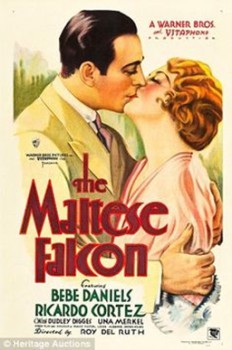 In 1931, Ricardo Cortez starred as Sam Spade in the first Falcon, also known as Dangerous Female. I will refer to it by that name to differentiate it from the 1941 version. Only a month before its premiere, its title was changed from Woman of the World. This version followed the book fairly closely and involved more overt references to sex, being pre-Code (Hollywood instituted a self-censorship guideline; usually known as the Hayes Code, which lasted until 1968). It also includes the original ending from Hammett’s book, which is NOT the one most people believe it to be.
In 1931, Ricardo Cortez starred as Sam Spade in the first Falcon, also known as Dangerous Female. I will refer to it by that name to differentiate it from the 1941 version. Only a month before its premiere, its title was changed from Woman of the World. This version followed the book fairly closely and involved more overt references to sex, being pre-Code (Hollywood instituted a self-censorship guideline; usually known as the Hayes Code, which lasted until 1968). It also includes the original ending from Hammett’s book, which is NOT the one most people believe it to be.
Cortez was tough, but more elegant. He reminded me more of the ‘gentleman thief’ persona than of a hard-bitten private eye. This is the second-best version of The Falcon, but there’s nothing particularly notable about it.
The Second Falcon
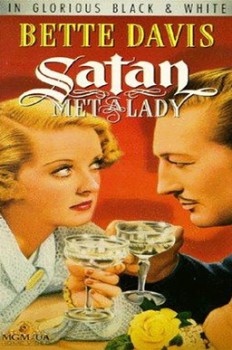 1936’ Satan Met a Lady goes for laughs and changes all the names. Bette Davis has top billing over Warren Williams (who is Shane, not Spade), Caspar Gutman is a woman and the falcon is now the Horn of Roland! This loose adaptation is more in the vein of The Thin Man (another Hammett property) than Hammett’s hardboiled story.
1936’ Satan Met a Lady goes for laughs and changes all the names. Bette Davis has top billing over Warren Williams (who is Shane, not Spade), Caspar Gutman is a woman and the falcon is now the Horn of Roland! This loose adaptation is more in the vein of The Thin Man (another Hammett property) than Hammett’s hardboiled story.
I watched it once and have never bothered to revisit. The New York Times said,
A cynical farce of elaborate and sustained cheapness, it causes still other intelligent actors and actresses – including Warren Williams, Arthur Treacher and Alison Skipworth – to behave like numskulls and deserves to be quoted as a classic of dullness…
The review actually gets harsher!
Bogart appeared with Bette Davis five times. He had a minor role in 1932’s Three on a Match, which also included Warren Williams. Then, in 1936, he secured a permanent spot in Hollywood with his performance as Duke Mantee in The Petrified Forest. The next year, they were both in Marked Woman and Kid Galahad (Elvis’ version is a remake, kids). Finally, in 1939, Bogie garnered third billing in Dark Victory, playing an Irish stable hand. Still two years away from his High Sierra breakthrough, Bogart earned praise for his out-of-the-norm romantic role. Almost-Falcon costar Geraldine Fitzgerald was in the cast, as was a future president named Ronald Reagan.
Davis and Bogart had one thing in common: they hated the studio system that kept actors’ wages down and all but eliminated their options to move between studios or pick their roles. Both played significant parts in changing the system (Bogart’s through the founding of his own company, Santana Films). Incidentally, both had cameos in 1943’s Thank Your Lucky Stars. For four days, they co-starred in The Old Maid. But after seeing Bogie’s dailies, he was deemed so unromantic that he was dropped for George Brent!
The Classic
We’ll spend some time on the 1941 version, which I consider to be the greatest private eye movie ever made. First, we’ll look at the man who made it happen. Believe me, there was zero expectation that this movie would matter much when it was slated for production. No one, even John Huston himself, could have imagined it would become one of the greatest mystery movies ever filmed!
John Huston
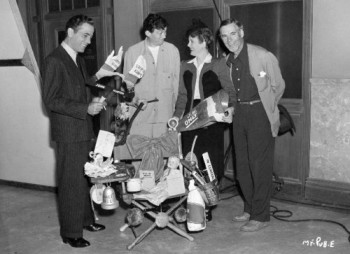
John Huston had been a successful scriptwriter for Warner Brothers, with Sergeant York (Gary Cooper) and High Sierra (Humphrey Bogart) being box office hits. He also wrote The Amazing Dr. Clitterhouse, an Edward G. Robinson vehicle in which Bogie co-starred. Warners decided to toss Huston a bone and let him direct a movie and he wanted to do The Falcon. It was a low-budget effort, using B actors, and a remake of a property the studio owned. Low risk and low cost worked for Warners and he was told to work on a screenplay.
The story, told by Huston and supported by others, is that he instructed his secretary to take the book and type it up in screenplay format: then promptly went on vacation. Studio head Jack Warner somehow saw this book-screenplay, liked it and gave the green light for the project.
It is well known among fans of the book that the 1941 version cuts out a parable about Mister Flitcraft and the falling beam, and it also got rid of Gutman’s daughter. And of course, it changed the ending. But by sticking with Hammett’s story and tone, it was light years away from Satan Met a Lady. And by incorporating significant amounts of dialogue from the book, it differentiated itself from the first version, Dangerous Female. Huston actually managed to put Hammett’s novel on the screen: something that two previous directors had failed to do, to their detriment. As he himself said, “I decided on a radical procedure: to follow the book rather than depart from it.” And that was an unusual approach for Hollywood!
Bogart went from bad guy to hero in this movie, as Huston’s Sam Spade is actually nobler and more admirable than Hammett’s original (though still no saint). For example, the book ends with Spade resuming his affair with his partner’s widow: that was replaced with the “The thing that dreams are made of” line.
Bogart and Raft
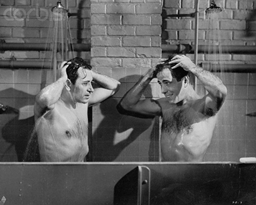
Next week’s post is going to look at the many instances where Raft turned down roles that Bogart ended up with. It reads like The Complete Idiot’s Guide To Wrecking Your Own Career. As for how that worked out, Raft said of The Maltese Falcon, “There but for the grace of me, go I.”
Raft was the studio’s first choice for The Falcon (though Huston always wanted Bogie). Jack Warner had promised Raft that he would only have to appear in important pictures. Raft reminded Warner of this and told him that The Maltese Falcon was not an important picture. Also, his contract allowed him to avoid remakes, so he refused the part.
Raft had gotten Bogie kicked off of Manpower (replaced by Edward G. Robinson). A week later, Bogart received the script for Bad Men of Missouri and sent it back with a note that included, “Are you kidding?” He was immediately suspended. Bogart was still on suspension when he was assigned to The Falcon.
Huston played a significant role in Humphrey Bogart elevating from a B actor to a Hollywood star. He wrote High Sierra, which was Bogie’s first major jump from supporting actor (usually gunned down by the star) and he wrote and directed The Maltese Falcon. Without those two successes (both parts were turned down by Raft), it’s unlikely Bogart would have been cast in Casablanca.
Mary Astor
Geraldine Fitzgerald refused the part of the movie’s femme fatale and the scandalous Astor landed the role. For me, she’s not nearly conniving enough and just too blah. She is the Achilles heel of the cast. I think she was better suited opposite Bogie in Across the Pacific.
Sydney Greenstreet
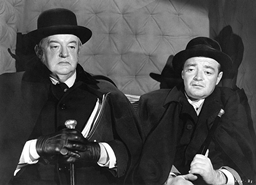 Huston saw the corpulent Greenstreet on stage in LA and convinced the sixty-one year old actor to appear in a film for the first time. Greenstreet, who asked Mary Astor to hold his hand and keep him from making an ass of himself, dominated scene after scene and it’s hard to imagine anyone else in the role of ‘The Fat Man.’ Greenstreet and Peter Lorre made a fine pairing and appeared in eight other films together. Including an ‘almost-sequel’ to The Falcon. It is certainly fortuitous that Huston convinced Greenstreet to join the cast, as the Lorre-Greenstreet pairing would never have occurred otherwise. And if you’ve seen The Mask of Dimitrios, you know that would have been a shame. It’s hard to believe, but Greenstreet had primarily played comedic roles on stage.
Huston saw the corpulent Greenstreet on stage in LA and convinced the sixty-one year old actor to appear in a film for the first time. Greenstreet, who asked Mary Astor to hold his hand and keep him from making an ass of himself, dominated scene after scene and it’s hard to imagine anyone else in the role of ‘The Fat Man.’ Greenstreet and Peter Lorre made a fine pairing and appeared in eight other films together. Including an ‘almost-sequel’ to The Falcon. It is certainly fortuitous that Huston convinced Greenstreet to join the cast, as the Lorre-Greenstreet pairing would never have occurred otherwise. And if you’ve seen The Mask of Dimitrios, you know that would have been a shame. It’s hard to believe, but Greenstreet had primarily played comedic roles on stage.
Fans of Greenstreet’s performance might do well to check out his radio series as Nero Wolfe (which I mentioned here a mere two weeks ago). He plays the role far more like Gutman than he does Wolfe: which is part of my problem with the show.
Peter Lorre
Joel Cairo had been played rather unremarkably in the first film and for comic relief in the second. Lorre created the portrayal that is synonymous with Joel Cairo. More overtly homosexual in the book, he’s merely effeminate and flamboyantly attired in the film. His attempt to search Spade’s office is a highlight of the movie. This is one of his finest supporting roles.
It’s Elementary – Thought we’d get through a whole post without a Sherlock Holmes reference, didn’t you? I love Lorre both as Cairo and as Casablanca’s Ugarte. Go watch Granada’s The Greek Interpreter, starring Jeremy Brett as Holmes. Wilson Kemp is played by a man named George Costigan. It is hands down the most Peter Lorre-like performance I’ve ever seen by anyone. He would have been perfect to play any Lorre role in a remake. I have it on DVD but you can find it on Youtube. A superb job.
Elisha Cook Jr.
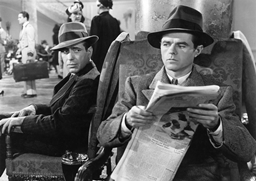 Cook so disliked the Hollywood scene that he lived alone up in the mountains. When he was wanted for a part, a messenger was sent up to him and he came down to work. As the tough-talking gunsel (that word doesn’t mean what you think it does), he doesn’t have a lot of lines but he has some strong scenes.
Cook so disliked the Hollywood scene that he lived alone up in the mountains. When he was wanted for a part, a messenger was sent up to him and he came down to work. As the tough-talking gunsel (that word doesn’t mean what you think it does), he doesn’t have a lot of lines but he has some strong scenes.
Walter Huston
John got his father Walter, a successful actor, to appear (uncredited) in one scene. Walter played Captain Jacobi, staggering into Spade’s office, giving him the falcon and then dying of his gunshot wounds. John played a joke on his father and reshot the scene over and over. The following day, he had Astor pretend to be his secretary and call Walter, telling him they needed to redo the scene again. Walter retorted that he was bruised from falling so often in the prior day’s shooting and that his son could get another actor or go to hell! The senior Huston was great opposite Bogart in Treasure of the Sierra Madre.
The Sequel?
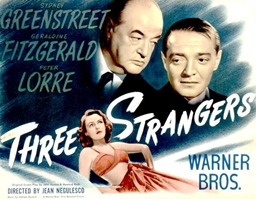 John Huston had written an unproduced screenplay a few years earlier. He and Warners planned to rework it, change the character names and reunite Bogart, Greenstreet, Lorre and Astor in a sequel to The Maltese Falcon. However, legal research established that Warner only had rights to The Falcon: not the characters. With some help from friend Howard Koch (who worked on the Casablanca script), Huston ended up writing Three Strangers, featuring Greenstreet and Lorre opposite Geraldine Page (the original pick for Brigid O’Shaughnessy). It’s an adequate film, but certainly not on a par with The Falcon. Peter Lorre isn’t a bad guy, which is certainly not the norm.
John Huston had written an unproduced screenplay a few years earlier. He and Warners planned to rework it, change the character names and reunite Bogart, Greenstreet, Lorre and Astor in a sequel to The Maltese Falcon. However, legal research established that Warner only had rights to The Falcon: not the characters. With some help from friend Howard Koch (who worked on the Casablanca script), Huston ended up writing Three Strangers, featuring Greenstreet and Lorre opposite Geraldine Page (the original pick for Brigid O’Shaughnessy). It’s an adequate film, but certainly not on a par with The Falcon. Peter Lorre isn’t a bad guy, which is certainly not the norm.
The Black Bird
In 1975, George Segal starred as Sam Spade Jr. in The Black Bird, a parody sequel to The Maltese Falcon. Lee Patrick reprised her role as Effie Perrine, Sam’s secretary, but she’s now a loud, overweight shrew who harangues Segal throughout the film. Elisha Cook, Jr. is also back as Wilmer. And of course, the famed black bird is center stage. It’s dumb, but I think it’s funny. As you can see from the picture to the left, it’s a pretty silly movie. Now, in a more clever take on humor, Peter Falk played a very Sam Spade-like figure in The Cheap Detective, which I think is an under the radar classic. But I love Peter Falk, be it Columbo or The In-Laws. He had previously played a Spade character in the ensemble mystery comedy, Murder By Death.
Radio
There were three major radio adaptations of The Maltese Falcon at the time: the first starring Edward G. Robinson and the latter two with Bogie reprising his role. There were well over 200 episodes of The Adventures of Sam Spade, a very popular radio show, primarily starring Howard Duff. Duff’s Spade bore little resemblance to Hammett’s character and was indistinguishable from other wisecracking detectives of the era.
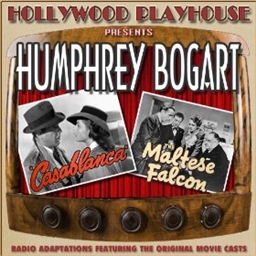 In 1948, a special two-part, one-hour episode was recorded: The Khandi Tooth Caper. Written for radio, it was a sequel to The Maltese Falcon, featuring Spade, Kaspar Gutman, Joel Cairo and Wilmer Cook’s younger brother. Philip Marlowe makes a cameo, played by Robert Montgomery. Montgomery starred and directed in the 1947 film version of The Lady in the Lake. That’s the one with point of view from the camera. It takes some getting used to. I haven’t managed it yet. The Khandi Tooth Caper meanders around for a while and the second half clearly copies The Maltese Falcon. I’ll let you be the judge of its place in Falcon history.
In 1948, a special two-part, one-hour episode was recorded: The Khandi Tooth Caper. Written for radio, it was a sequel to The Maltese Falcon, featuring Spade, Kaspar Gutman, Joel Cairo and Wilmer Cook’s younger brother. Philip Marlowe makes a cameo, played by Robert Montgomery. Montgomery starred and directed in the 1947 film version of The Lady in the Lake. That’s the one with point of view from the camera. It takes some getting used to. I haven’t managed it yet. The Khandi Tooth Caper meanders around for a while and the second half clearly copies The Maltese Falcon. I’ll let you be the judge of its place in Falcon history.
Warner Brothers sued the makers of the radio show for infringing on their property rights of The Maltese Falcon. Hammett had himself added as plaintiff. They won, though the series had ended a few years before a ruling was finally made. Duff, who was married to Ida Lupino for a time, got caught up in Hollywood’s ‘red scare’ nonsense and his career suffered considerably: he even lost his job as Spade.
While I prefer Yours Truly, Johnny Dollar and Richard Diamond (who you read about here, of course!), The Adventures of Sam Spade is an entertaining radio series: just not very Hammett-like.
A Play?
Lawrence Stallings obtained the rights to The Maltese Falcon and in 1931 wrote a stage play called Here’s To Crime. It was never satisfactorily finalized and the play wasn’t produced. Stallings’ rights expired in 1946, presumably because Howard Duff’s radio show was about to begin.
Huston and Bogart
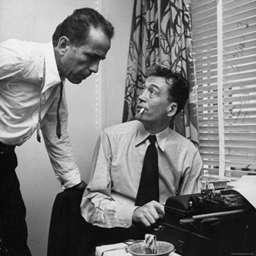 John Huston and Humphrey Bogart made six films together. The Maltese Falcon and Treasure of the Sierra Madre are considered classics. The African Queen (which garnered Bogie his only Academy Award) and Key Largo are critical hits and could also fit in the first category. Across the Pacific reunited Bogie, Astor and Greenstreet in an attempt to cash in on Casablanca: it’s a solid film. Beat the Devil is a bit of a mess and quite inferior to the first four. But otherwise, when Huston directed Bogart, magic was made on screen. And it started with The Maltese Falcon.
John Huston and Humphrey Bogart made six films together. The Maltese Falcon and Treasure of the Sierra Madre are considered classics. The African Queen (which garnered Bogie his only Academy Award) and Key Largo are critical hits and could also fit in the first category. Across the Pacific reunited Bogie, Astor and Greenstreet in an attempt to cash in on Casablanca: it’s a solid film. Beat the Devil is a bit of a mess and quite inferior to the first four. But otherwise, when Huston directed Bogart, magic was made on screen. And it started with The Maltese Falcon.
If you’ve never read The Maltese Falcon, you’re missing out on one of the great pieces of mystery literature. And since a great movie was made from a great novel, starring one of the greatest actors, you should watch the 1941 film if you’ve never seen it. I have an unabridged reading of the book by William Dufris that has helped me pass several commutes to and from work over the years.
I’m a bit surprised there hasn’t been, or isn’t planned, an annotated version of The Maltese Falcon. With Hammett’s literary standing and the San Francisco setting, I’d think that would be a natural.
It Really is a Fantastic Book
I mentioned the ‘Flitcraft’ parable that was omitted from the film. Basically a happily married, successfully employed man was walking down the street one day when a falling beam nearly strikes and kills him. Shaken, he simply disappears and begins a new life somewhere else. And he becomes a happily married, successfully employed man. He is jarred out of his routine, starts over, but falls back into the same routine. That parable reflects Sam Spade’s life in the novel. The film doesn’t suffer for lacking it, but it’s an example of the depth of Hammett’s work in The Maltese Falcon. Go ahead and read it. Trust me.
See It on the Big Screen
Later this month, on February 21 and February 24, you’re going to have the opportunity to see The Maltese Falcon on the big screen at theaters across the nation. We’re talking about a movie made 75 years ago, based on a book written 86 years ago and starring an actor who died 59 years ago. And movie, book and actor are still exerting their influence today. I cannot strongly enough recommend that you take advantage of this opportunity. I have seen The Falcon (at the majestic Ohio Theater) and it’s even more marvelous on a movie screen. I’ll even predict it’s got a pretty good chance of being the best movie you’ll go to in 2016.
You can read Bob Byrne’s ‘The Public Life of Sherlock Holmes’ column here at Black Gate every Monday morning.
He founded www.SolarPons.com, the only website dedicated to the ‘Sherlock Holmes of Praed Street’ and blogs about Holmes and other mystery matters at Almost Holmes.
His “The Adventure of the Parson’s Son” is included in the largest collection of new Sherlock Holmes stories ever published. Suprisingly, they even let him back in for Volume IV!
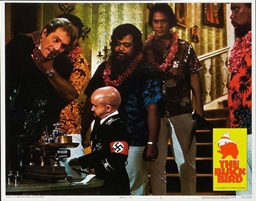
[…] Today over at Black Gate, ‘The Public Life of Sherlock Holmes’ has a post on one of my favorite books and movies, The Maltese Falcon. The main discussion is about Humphrey Bogart’s 1941 film version, which presaged the advent of film noir. But I talk about a lot of other stuff related to this great topic. […]
When I put this together, all the subheads were lined up properly. Not so much when I look at it on this PC (not the one I created from). Apologies if it looks out of whack.
Thanks for this post, Bob,I’m a big fan of Hammett, and of the film, which I rewatch regularly. We often quote from it around the house — not as often as the Princess Bride, but often.
The novel is grittier than the film, but I think that’s par for the course given the time period. You don’t mention The Thin Man, though, of course, it’s not really noir or hardboiled, is it? Another case of a great movie, perfectly casted, made from an even greater book.
Violette – I’m just not a fan of The Thin Man – book or films. The whole tone doesn’t work for me, though most of my Hammett/hard boiled fan friends do like it. So, I’m just a quiet minority (usually I’m a noisy minority).
Somewhere down the line, I’m going to do a post on John Maddox Roberts’ pastiche, ‘Conan the Rogue.’ It draws heavily on Red Harvest, which I think makes it about the best of the Tor series. I LOVE Red Harvest.
[…] week, The Public Life of Sherlock Holmes looked at The Maltese Falcon: primarily focusing on Bogart’s 1941 classic film. Well, that gave me the opportunity to […]
I went and saw ‘The Maltese Falcon’ on the big screen on Sunday, February 21. And I really focused in on the movie. It was a great experience. Just watching Bogart’s facial expressions in different scenes showed what an excellent actor he was.
And the photography was outstanding.
Well worth $12, even though I’ve seen it a dozen times, once before in the theater and I own the special DVD set. Great experience.